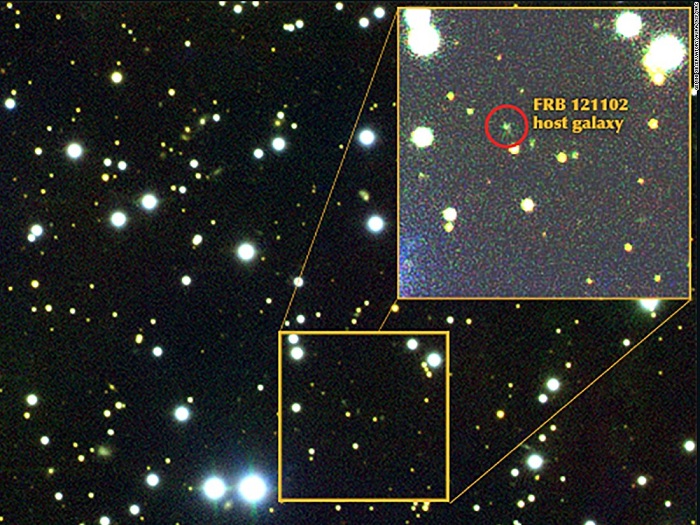Scientists originally thought the signal -- sporadic bursts of radio waves -- was coming from within the Milky Way itself, or from our closest galactic neighbors, but a new report in the journal Nature confirms it emanates from a tiny galaxy 1% the mass of our own.
"These radio flashes must have enormous amounts of energy to be visible from over 3 billion light-years away," Cornell University researcher Shami Chatterjee said in a statement.
Visible-light image of the dwarf galaxy from which signal FRB121102 is emanating.
Distant signals
Fast radio bursts were first discovered in 2007, and scientists have been trying to ascertain their origin and cause ever since.
There are currently 18 known FRBs, but they were all detected by non-specialist radio telescopes that were unable to narrow down their origin to a precise location, according to researchers at McGill University.
In 2012, scientists at Cornell spotted that one signal just three one-thousandths of a second long -- FRB121102 -- was repeating sporadically.
"There`s a patch of the sky from which we`re getting this signal -- and the patch of the sky is arc minutes in diameter. In that patch are hundreds of sources. Lots of stars, lots of galaxies, lots of stuff," Chatterjee said.
After more than 50 hours examining the skies hoping to get a spot of the signal, they got lucky, and were able to trace it to its origin.
What next?
Now than an FRB has been traced to its origin, scientists may finally be close to explaining what causes the peculiar signals.
Unfortunately for alien enthusiasts, extraterrestrial intelligence is not near the top of the list of explanations.
"We think it may be a magnetar -- a newborn neutron star with a huge magnetic field, inside a supernova remnant or a pulsar wind nebula -- somehow producing these prodigious pulses," Chatterjee said.
Neutron stars are incredibly small and dense objects with a mass around twice that of the sun. They are formed by the supernova explosion of a massive star as it reaches the end of its lifespan and detonates its remaining fuel in spectacular fashion.
An artist's rendering of an outburst on an ultra-magnetic neutron star, also called a magnetar.
An artist`s rendering of an outburst on an ultra-magnetic neutron star, also called a magnetar.
The signals could also be caused by a black hole at the center of the dwarf galaxy -- also known as an active galactic nuclei -- which gives off bursts of light as particles fall into at incredible speed.
While these are the most common explanations for FRBs, Bryan Butler of the National Radio Astronomy Observatory pointed out that they may not apply to this particular signal.
"We do have to keep in mind that this FRB is the only one known to repeat, so it may be physically different from the others," he said in a statement.
More about:
















































